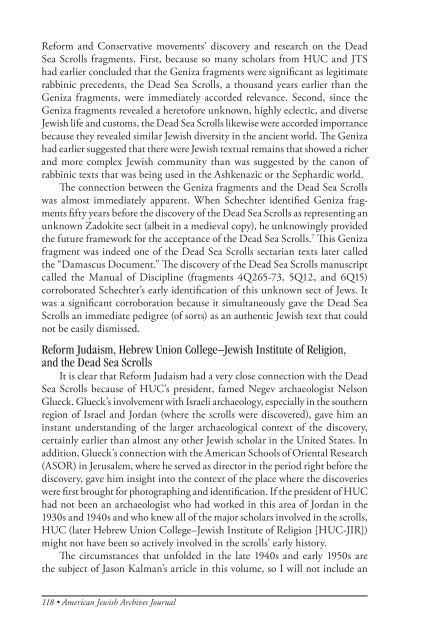The American Jewish Archives Journal, Volume LXI 2009, Number 1
The American Jewish Archives Journal, Volume LXI 2009, Number 1
The American Jewish Archives Journal, Volume LXI 2009, Number 1
Create successful ePaper yourself
Turn your PDF publications into a flip-book with our unique Google optimized e-Paper software.
Reform and Conservative movements’ discovery and research on the Dead<br />
Sea Scrolls fragments. First, because so many scholars from HUC and JTS<br />
had earlier concluded that the Geniza fragments were significant as legitimate<br />
rabbinic precedents, the Dead Sea Scrolls, a thousand years earlier than the<br />
Geniza fragments, were immediately accorded relevance. Second, since the<br />
Geniza fragments revealed a heretofore unknown, highly eclectic, and diverse<br />
<strong>Jewish</strong> life and customs, the Dead Sea Scrolls likewise were accorded importance<br />
because they revealed similar <strong>Jewish</strong> diversity in the ancient world. <strong>The</strong> Geniza<br />
had earlier suggested that there were <strong>Jewish</strong> textual remains that showed a richer<br />
and more complex <strong>Jewish</strong> community than was suggested by the canon of<br />
rabbinic texts that was being used in the Ashkenazic or the Sephardic world.<br />
<strong>The</strong> connection between the Geniza fragments and the Dead Sea Scrolls<br />
was almost immediately apparent. When Schechter identified Geniza fragments<br />
fifty years before the discovery of the Dead Sea Scrolls as representing an<br />
unknown Zadokite sect (albeit in a medieval copy), he unknowingly provided<br />
the future framework for the acceptance of the Dead Sea Scrolls. 7 This Geniza<br />
fragment was indeed one of the Dead Sea Scrolls sectarian texts later called<br />
the “Damascus Document.” <strong>The</strong> discovery of the Dead Sea Scrolls manuscript<br />
called the Manual of Discipline (fragments 4Q265-73, 5Q12, and 6Q15)<br />
corroborated Schechter’s early identification of this unknown sect of Jews. It<br />
was a significant corroboration because it simultaneously gave the Dead Sea<br />
Scrolls an immediate pedigree (of sorts) as an authentic <strong>Jewish</strong> text that could<br />
not be easily dismissed.<br />
Reform Judaism, Hebrew Union College–<strong>Jewish</strong> Institute of Religion,<br />
and the Dead Sea Scrolls<br />
It is clear that Reform Judaism had a very close connection with the Dead<br />
Sea Scrolls because of HUC’s president, famed Negev archaeologist Nelson<br />
Glueck. Glueck’s involvement with Israeli archaeology, especially in the southern<br />
region of Israel and Jordan (where the scrolls were discovered), gave him an<br />
instant understanding of the larger archaeological context of the discovery,<br />
certainly earlier than almost any other <strong>Jewish</strong> scholar in the United States. In<br />
addition, Glueck’s connection with the <strong>American</strong> Schools of Oriental Research<br />
(ASOR) in Jerusalem, where he served as director in the period right before the<br />
discovery, gave him insight into the context of the place where the discoveries<br />
were first brought for photographing and identification. If the president of HUC<br />
had not been an archaeologist who had worked in this area of Jordan in the<br />
1930s and 1940s and who knew all of the major scholars involved in the scrolls,<br />
HUC (later Hebrew Union College–<strong>Jewish</strong> Institute of Religion [HUC-JIR])<br />
might not have been so actively involved in the scrolls’ early history.<br />
<strong>The</strong> circumstances that unfolded in the late 1940s and early 1950s are<br />
the subject of Jason Kalman’s article in this volume, so I will not include an<br />
118 • <strong>American</strong> <strong>Jewish</strong> <strong>Archives</strong> <strong>Journal</strong>

















